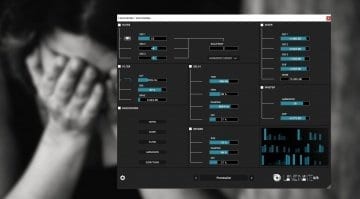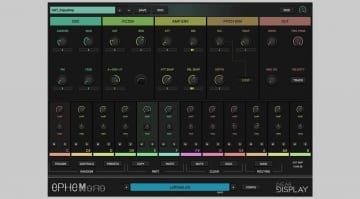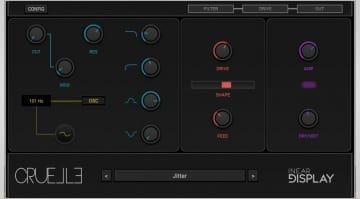Incipit from Inear Display is a toolbox full of delay
Initially I thought it was called Insipid which is really not what they’re going for. “Incipit” is defined as the first few words of a text or the initial sequence of notes in a musical composition. So top marks for finding an obscure but completely relevant name for your delay plug-in!
Incipit is a stack of 3 effect chains each one consisting of a pitch shifter and a delay followed by an amp (are level and pan classed as effects?). These feed through a filter and out via an oscilloscope display in the middle of the GUI. At the bottom you have a row of 4 LFO’s ready and willing to start modulating. The Pitch Shifter feels very granular and has two knobs called Size and Feed which affects the delay to the shift and the amount of output fed back to the input. Even the initialised patch has these on and working so if you want to play with just delay you’ll need to turn the mix down on the pitch shift on all 3 chains. The delay is very simple with synced or free time up to a second in length, feedback and mix.
Having 3 chains allows you to build up some quite interesting and complex delay effects. The pitch shifting is much less pure but no less interesting when it comes to creating strange and evolving textures. The presets are initially disappointing because there appears to be only a handful and they start off with some light modulation and grainy pitch effects when what I really want is an impressive delay to kick things off. However, if you click on the preset name rather than the arrows it reveals a whole folder system of interesting and weird undiscovered presets that float my boat a great deal more.
The key to the weirdness is of course in the modulation matrix – everyone has to have one these days it seems. This is where you map the LFOs to whatever parameter you want to control. It’s thankfully nice and big, making it easy to see what’s going on. On the controls page the LFO allocation is indicated by a green line around the knob – it’s the same sort of green line for each LFO so you can’t actually tell which LFO is controlling what just by looking at it. I’d like to see some sort of animation on the knobs showing what the LFO’s are doing and different colours on each – but that’s being very picky and this certainly works very well. You also have three Macro knobs to which you can map any and all parameters for some instant chaos inducing modulation. Lastly there’s a Randomizer panel that can conjure up sounds by randomising the parameters of the LFOs, Effects or Matrix or the whole lot at once.
The scope for sound design and mutated noises is large and easy to achieve. The interface is clear and well laid out and looks better scaled up – they let you scale up to 200% which is vital these days and very welcome. As a bonus it appears to be totally multi-touchable if you are running a touch screen or Windows Surface, tablet or hybrid. It also has a comprehensive user guide and a demo version you can try for free.
Incipit is available not for AU and VST, OSX and Windows for EUR €39.
More information: https://ineardisplay.com/plugins/incipit/










